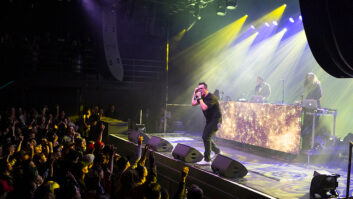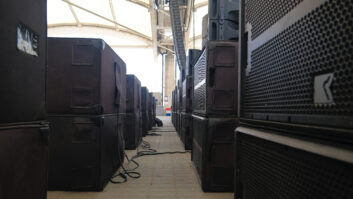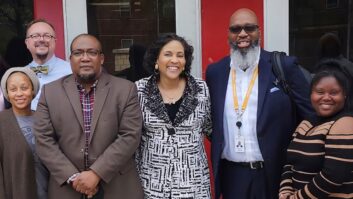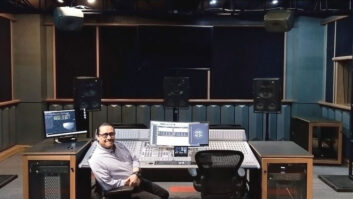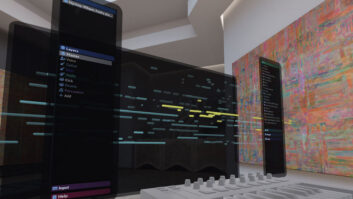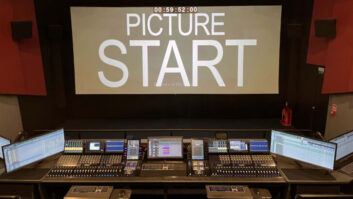
Countdown to showtime, from left: system tech Wade Crawford, Beyonce FOH engineer Horace Ward and Dave Skaff, Alicia Keys’ FOH engineer
Photo: Strother Bullins
Shortly after the doors open at 6 p.m., a smiling mother and her two enthusiastic children hurry to find their reserved floor seats at North Carolina’s Greensboro Coliseum. The teenage son holds a jersey emblazoned with the logo of hip hopper Missy Elliott, while his younger sister already wears a slightly oversized shirt featuring Beyoncé’s face. “They’re here to see Missy and Beyoncé,” mom excitedly explains, “but I can’t wait for Alicia!”
This family’s enthusiasm illustrates the strengths of this spring’s big Verizon Ladies First Tour 2004, featuring Beyoncé, Alicia Keys and Missy Elliott with special guest Tamia. And this isn’t one major production — it’s three of them.
Ladies First offers something for everyone, and each superstar’s set is that of a full-blown headliner, complete with massive production elements that require 14 tractor-trailers moving from city to city. The lineup is an excellent showcase for three of today’s top female R&B artists. Beyoncé offers her formidable vocal talents while delivering what some on the tour refer to as “The Show”; Keys gives a dynamic, stylistically diverse performance with sophisticated sexiness; and Elliott’s groundbreaking raps, sounds and visuals are charged with both humor and unbounded energy. With so much happening daily on Ladies First, what is the biggest challenge for the tour’s consummate team of audio professionals?
“There’s just not enough time in the day,” laments Dave Skaff, Keys’ front-of-house engineer. “It seems like the biggest challenge is that we don’t have quite enough time for everything that needs to be done. On one hand, you have Beyoncé’s production, her band and the things they need to do. Then from my point of view, Alicia’s show has a 10-piece band, and there’s rarely time to soundcheck everything. So it’s very intense, very challenging.”
Beyoncé’s FOH engineer, Horace Ward, agrees, adding that the greatest challenges involve set changes. “Missy has a three-piece, goldfish bowl — like set, with video screens at the front, steps up to the side and a DJ hung over the top on a hydraulic. Then Alicia comes on with band risers, a central elevator platform with steps, her drops, curtains and so on. Then we come on. So, logistically, you’re putting up three headliners.”
CHOOSING THE RIGHT GEAR
Kicking off the tour in Fort Lauderdale, Fla. (which is where stage photos were taken), the Ladies First Tour hit the road with a Showco system, complete with an 80-piece, Crown-powered Prism Series array and the new Prism 2 subwoofer system. According to Ward, the hearty Prism system coupled with the new subs works extremely well for Beyoncé’s set. “Because it’s a dynamic performance,” he explains, “they need a dynamic sound. Not necessarily anything that’s going to hurt you, though. That’s why I chose the Prism. I can get it up SPL-wise, and everyone can walk out without their ears ringing.”
The tour’s large-scale production caused the audio team to look closely at equipment choices, specifically in the selection of FOH consoles. Ward and company decided to use four DiGiCo D5 Live digital consoles: two at FOH and two at stage left for monitoring and mirroring FOH. At stage right, a Yamaha PMD1 desk is designated for Keys’ monitoring needs.
Skaff has his own D5 — patched into the system via a Midas XL88 matrix mixer — while Ward and Elliott’s FOH engineer, Dennis Thompson, share the second FOH D5. Skaff, who first used the D5 on a 2003 Shania Twain tour, knew that the desk’s small footprint and easy configuration would work well for Keys’ set. “On this tour, because of the physical logistics going on, I can get by with this digital console and its input capability,” he explains. “With other desks, it would make our area out here so big, and production is really counting on the fact that we can do this stuff on smaller digital consoles.”
This was Ward’s first tour using the D5, and he has adapted easily. “I’ve used the Showco Showconsole in the past and I love that. Just for ease, though, I went with the smaller console. Logistically, getting around it is easy, and it’s a great-sounding board.”
Thompson, who agrees with Ward on the D5’s ease-of-use, also found himself working on the desk for the first time. “It’s the way to go,” he explains. “The technology is supreme, and it’s just the best thing going right now, especially for festivals and multiband participation things like this.”
Showco systems engineer Wade Crawford, who stays busy sussing out potential audio problems, explains that the team has made significant efforts to ensure that the show will go on no matter what unforeseen audio catastrophes may arise. “Since we all know that no audio is bad audio,” Crawford says with a chuckle, “at FOH, we have a drawer with a mixer in it. It has a left and a right off of an ear mix for monitors. If for some reason there’s FOH failure, we can keep the show going.”
Crawford says that there hasn’t been too much to worry about as far as tuning the system is concerned. “We’re running SIA SmaartLive out front, so they use that as a reference just to know what’s going on,” says Crawford. “Mostly, Horace is trying different things for Beyoncé, tuning the subs separately from the rest of the rig, and he’s on the right track.”
MEANS OF MONITORING
For this particular show, Keys’ musicians — the largest backing band on the tour — have made an effort to get the stage volume down, which clearly helps Keys’ audio team, specifically monitor engineer Larry Mignogna. “There are now 12 ear mixes, but there are also a few wedges,” he explains. “Before, Alicia was using one ear and one wedge, and I just got her to use two ears. I’m slowly trying to work the wedges out.”
The Yamaha PM1D works well for Mignogna. “This is my first tour with it and I love it,” he says. He felt more comfortable with the console, as tour rehearsals indicated what each player needed. “After I felt that everyone was pretty much set, I started doing scenes and particular changes for different songs, and it went well.” For the most part, everyone wanted everything: “There are a lot of full mixes,” says Mignogna.
On the other side of the stage, Beyoncé’s monitor engineer Ramon Morales “has a lot going on,” according to Ward. Beyoncé’s seven-piece band, three background singers and various dancers keep Morales on his toes. “He’s running the two D5s and something like 24 mixes off of the board,” Ward explains. “There are ear mixes for the backgrounds, Beyoncé has ear mixes and side-fills, the musicians are on individual wedges and the DJ’s on a wedge, too.”
IT’S SHOW TIME!
Kicking off the Greensboro date with one-third of the crowd in their seats, special guest — and the only artist resembling an “opener” — Tamia performed a short but energetic set on a sliver of stage with a simple black backdrop. The talented new vocalist, along with four background singers, was probably allowed every inch of available stage space, considering that three major sets were behind her waiting to be unveiled.
As quickly as the house lights went on, they dimmed once again, welcoming Missy Elliott, a troupe of dancers, co-rappers, a DJ and multiple levels of energy. The concert-meets-performance art show required Elliott’s FOH engineer to be ever vigilant while focusing on keeping everything aurally straightforward. Combining performance tracks, the live DJ and Elliot’s rapid-fire vocals, Thompson uses a bulletproof standard for the main vocal: “It’s the Shure SM58 capsule,” he says smiling. “It’s the best thing for hip hop and rap. It has sturdiness and robustness that you need. They take a licking and keep on ticking!”
For Elliott’s vocal chain, the simple approach also applies. “I’m using the D5’s internal compression,” explains Thompson. “For rap, you really don’t need anything more than that. I will sometimes use a dbx 160x, but the D5 compression is more than adequate. I also use a TC Electronic M6000 for reverb, which is my reverb of choice.”
For the next set, Keys brought a new vibe to the stage, offering the earnest delivery of a true singer/songwriter, supported by a superb band. The intense set, which runs more than 80 channels at FOH, is also what makes Skaff’s gig tough: “The thing about Alicia’s show — which is really the hard thing, but a good thing — is that there’s lots of real stuff up there,” he says. “It’s a real Rhodes, a real Wurlitzer, a real piano, a fully miked drum kit and so on. So, naturally, we’ve got a lot of microphones.”
For Keys’ vocals, Skaff uses a handmade prototype of the new Sennheiser 935. “I don’t even think they’re out yet,” says Skaff. The Manley VoxBox has also proven to be an invaluable link in the vocal chain. “Particularly for her, the VoxBox’s compression is great. Whatever it does, it does it so transparently. It is always doing what you want it to do, and it’s a wonderfully smooth-sounding unit.”
Keys’ satin-black Yamaha grand piano is double-miked with an AKG 414 pair, which is used with a piano module. “The microphones are really hard to get up and sound like anything at all when the band is rocking away at 108 dB onstage. When she’s doing things much quieter, sitting and playing the solo piano stuff, I can use them even more.”
Like Thompson, Skaff sings the praises of the TC M6000 and finds it well-suited for the show. “The sounds are great,” he says. “For each of the four stereo-in/stereo-out machines, I’ve got a little bit on everything: one’s on the vocals, one’s on the drums, another’s on the saxophone and another’s on percussion. It’s all on AES-in/AES-out, which takes up less holes — great for this tour.”
With so many complex textures happening, Skaff’s mixing style follows where Keys takes the band. “Generally, I just try to keep up with the band’s playing,” shrugs Skaff. “It’s about keeping it musical, keeping it interesting, keeping it exciting, keeping the lead up there, but never losing the band — ever.”
After Keys’ set and another quick changeover, Beyoncé made an exciting entrance from the back of the arena and was carried through the crowd on a white, sheer-curtained, fur-covered recliner. Again, the musical vibe changed, this time to a glitzy but sophisticated set, recalling intros to Sean Connery — era James Bond films set to a brand-new, bouncy soundtrack. An equal representation of sequencing and live musicians bubbled beneath Beyoncé’s powerful voice, which is exactly how Ward envisioned the live re-enactments of her Dangerously in Love debut to sound.
“You can listen to the album to hear how the song sounds,” says Ward, “but I always feel that a good live sound should sound better than the album. I go by how the band is playing, and it should be like stepping into the album, but as a 3-D mix.”
Running nearly 60 channels, Ward layers live drums, sequenced sound and soaring vocals to create the power of Beyoncé’s show. “Drums and bass are the standard, at least for me, coming from reggae,” says Ward. “The vocal is in there as well, but not so loud. It’s just dynamic and crystal-clear.”
For vocals, Ward uses the Neumann KMS 105 capsule with the 5000 Series handheld unit. “It’s a real mic,” he boasts. “It doesn’t have any built-in arcs or whatever.” From there, he uses the D5’s onboard mic preamps, an Avalon AD 2044 compressor and an Apogee 6-band parametric EQ. “I EQ the system with a CD,” he explains. “Then I voice her mic using the parametric to take out spots — ‘climatizing’ the mic to the system. Once you get rid of any mic midrange gust that clouds it, it’s so clear.”
Besides staying on his toes to mix each song, Ward also flips pages of his notebook full of show cues. “There are tons of little nuances that I do, and I have delay cues out the yin-yang,” he says. “It’s a labor-intensive show. Everything fits in with the movements, stage pieces, risers and music. It’s all-in-one.
“The audience wants to see and hear a real performance,” Ward continues. “If you experience this show, you leave saying, ‘Now that’s a show,’ you know what I mean?”
And on this Sunday night, it’s clear that the Ladies First audio team accomplished what they set out to do. An exhausted, but exhilarated crowd filed out of the arena, most of them wearing smiles — and more Beyoncé, Keys and Elliot merchandise than one person could count.

